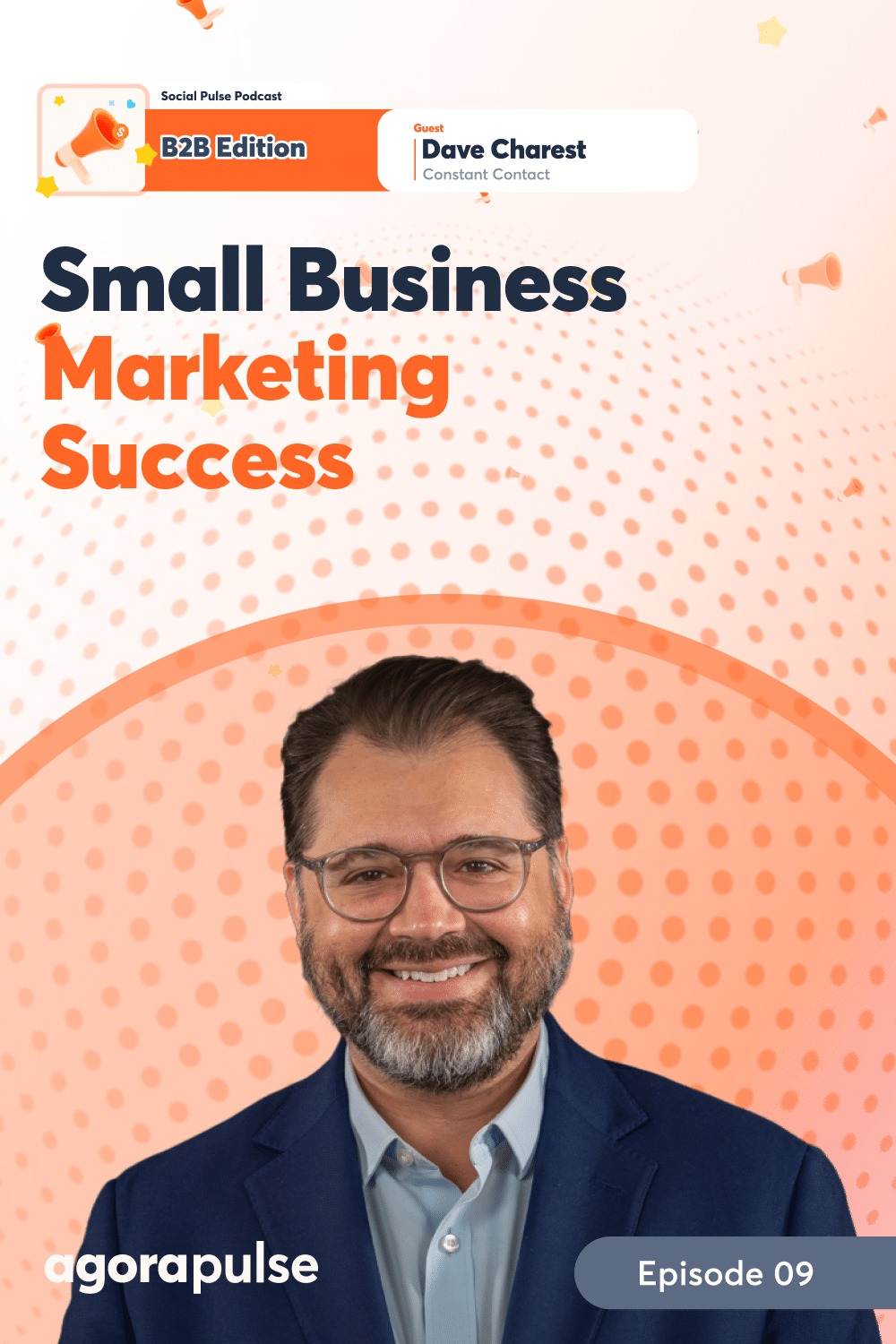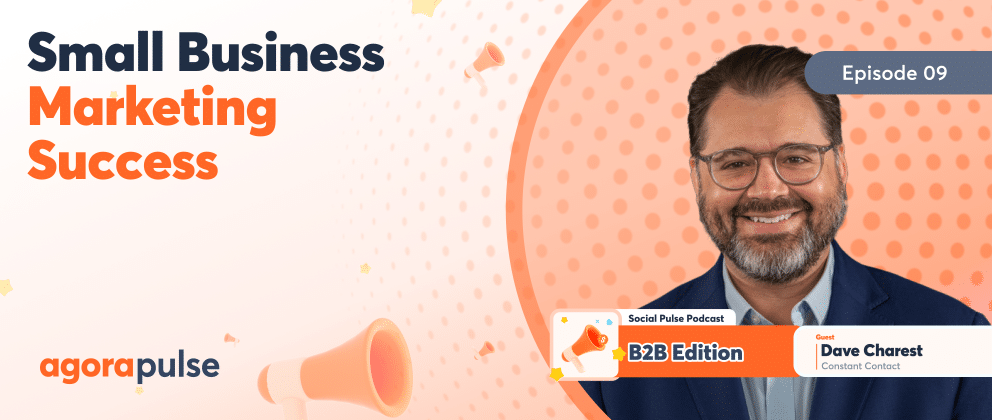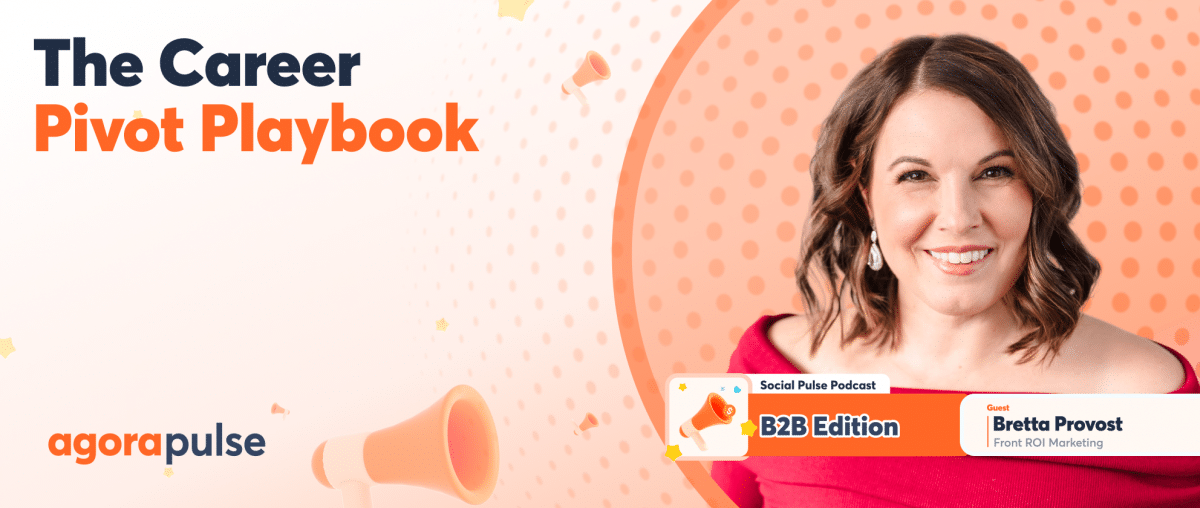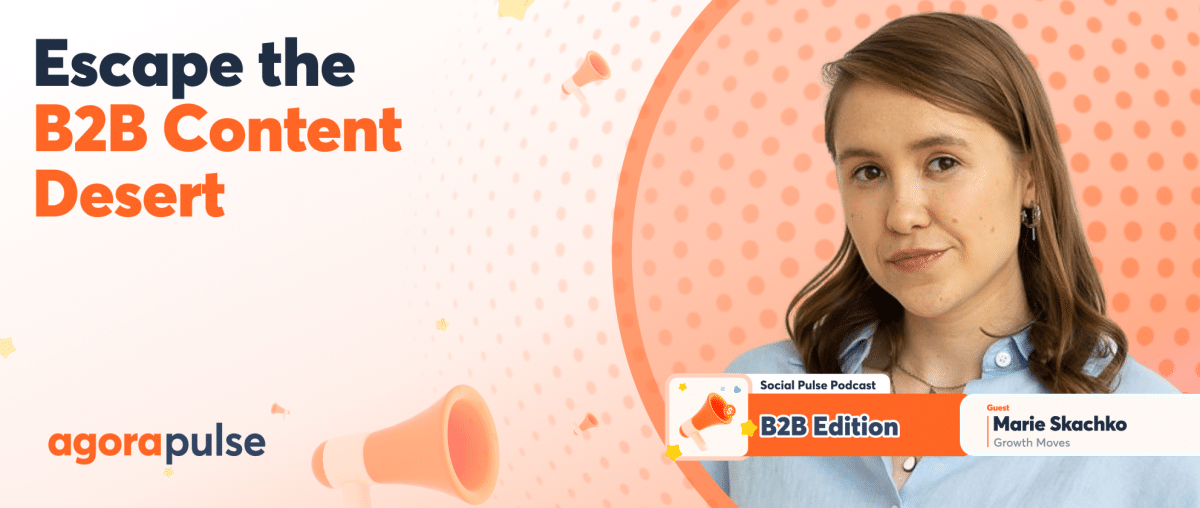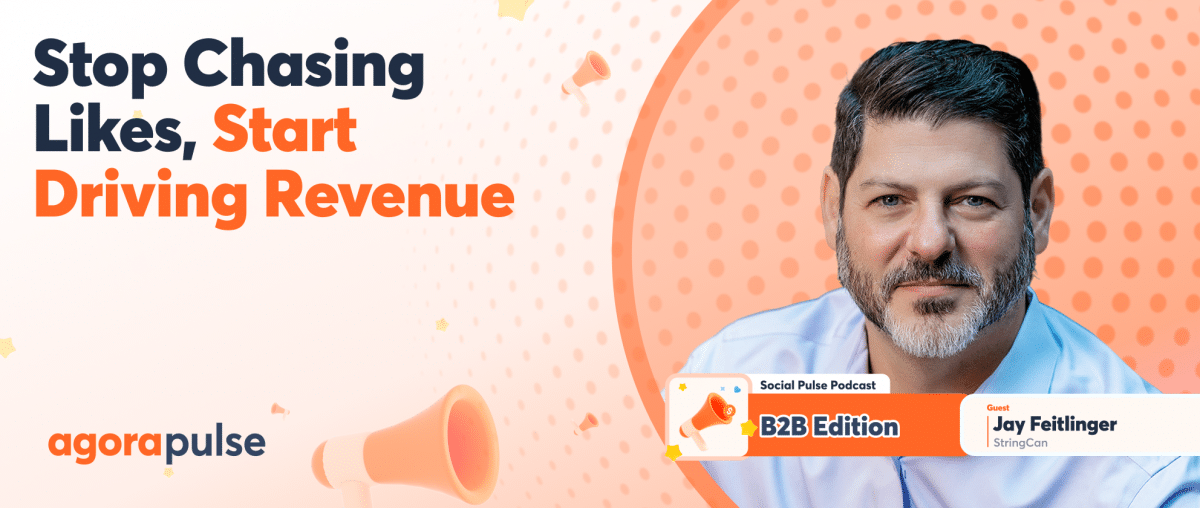What if we told you there was a “compass” that could guide your marketing efforts with laser-like precision? We’re going to discuss that compass in this overview of a Social Pulse Podcast episode. Our guest Dave Charest director of Small Business Success from Constant Contact, has distilled years of experience into what he calls the digital marketing success cycle for SMBs.
[Listen to the entire podcast, hosted by Agorapulse’s chief storyteller, Mike Allton, or read on for the transcript below.]
What’s the digital marketing success cycle for SMBs?
Dave Charest: Yeah. So maybe I’ll start with a story here as [I] stumbled into this a little bit. Last year and the year before, I’ve been doing a yoga challenge.I have to do 180 classes within 365 days to get a discount on my membership … And as I’m doing this, things don’t always go according to plan. So I miss a class here and there between travel, new work stuff, family things, all of that, all of that.
Each month, I end up checking in my calendar. I got a little tracker that I’m using, and I’m putting how many classes I’ve done and how many I have to do for the whole year. So I’m reviewing what I’m doing to see how my progress is going and then I’m making some adjustments.
So for the next month, all right, I have to make up this number of classes. I’m doing all that stuff. And then I’m putting those dates in my calendar, making sure I’m doing all that stuff. And as I’m doing this, I’m like, “Hey, this process actually feels a little bit familiar.” As you mentioned, I’ve been talking to a lot of small businesses over my time at Constant Contact and most recently for the Be a Marketer Podcast. And I’m like, “Oh, this actually feels really familiar.”
So reviewing, planning, and executing these kind of three things are things that I’ve heard time and time again from customers and small business owners of things that they’re doing.
- So I’ll give you some examples here: Marianne is a customer of ours who owns a consignment shop. She was telling us how she consistently is reviewing what she’s doing not only in her business but with her marketing efforts, so she can figure out what’s working and make those adjustments that she needs to make as you know as those come up.
- We’ve got folks like Nicole Stevenson who owns—or she runs these makers’ markets, I would say—and what she does is she works with their team as she’s putting on these markets and things figuring out how to market it and get the things together. She is working with her team to put that plan in place. “These are the things that we need to do. This is the timeline.” But then, she goes and actually breaks those things down into smaller tasks, preferably things that take like an hour or less so they can actually get some things done and start moving forward.
- And then we’ve talked to folks like Tameka Catchings. She is a former WNBA hall of famer who now owns a tea shop. She actually has three locations now. I believe she’s started bottling tea and selling in markets. One of the things she always talks about is that you actually need to schedule the work that you care about. So you have to actually put some time in the calendar and do something with it to actually get any of this done. And so that idea of review, plan, execute, it’s something that I hope becomes a mantra for people.
- Take this and you start applying this to what you’re doing. It’s really about looking at your approach. What are you doing from a marketing angle, and what tools are you using to help you do those things? And then how are you planning those efforts that you’re going to use these tools for to actually help you support your goals? And then how do you actually then execute those simple things and also boost your marketing productivity at the same time?
It’s that triumvirate of things review plan execute that this is all about.
Why do you think that’s crucial for small business owners and small business marketers in particular?
Dave Charest: Here’s some things that we know. Constant Contact actually does study study earlier in the year … If you look at the state of marketing, 56 percent of the people that we talk to actually have an hour or less to spend on marketing. Plus, 73 percent of them actually feel iffy about their marketing strategy.
Oftentimes because of that, 52 percent actually procrastinate on their marketing so they’re actually not doing the things right because they’d rather do anything else than do the marketing piece. And as you know, so many business owners got into business to do the thing that they love to do and not necessarily have to do the marketing. And so these are folks that I often say are business owners first and marketers by necessity.
When you take all of that into account, the stuff really becomes crucial because, in the review, this is where we can come in and say, “All right, here are the things that you need to focus on. Here are the things that you need to do. And they’re also iffy. So they’re not really sure. Then in the plan piece, how do you then use those tools to work towards your goals? How do you put a plan in place to use the tools to support that?”
[Often] everybody is offering advice, but they don’t take into account the actuality of what the individual business trying to do. And there are some things that, of course, you’re going to want to plan on because they’re going to help you, no matter what your goals are. Because they’re about bringing people closer to your business.
But then the harsh reality is you actually got to put the plan on the calendar. You’ve got to do it. I mean, you listen to this podcast, for example. You go to an event, you do all these things, you get so excited about all these ideas and things that you learn, and then you go back home. And then you don’t necessarily take action unless you put that time in the calendar. And so I think it’s critical and important because it gets you thinking about and asking the right questions and knowing what angles you need to go on but then also moving you forward.
All of these steps are action steps. It gets you moving forward. It gets you thinking about progress over perfection. I think doing something is always better than doing nothing. And this helps you start to get into that mentality.
The Cycle vs. Traditional Marketing
How does this cycle differ from “traditional marketing,” whether that’s the roles or the responsibilities or the approach?
Dave Charest: Well, I’m gonna say this. I don’t think it does differ, and I say that because I think what it is is just a practical, simple plan. I think we’ve got so much out there now. There’s so much noise out there now telling you you’re not doing it the right way. Essentially trying to get you to buy something or buy into something.
And so there’s a lot of things that are like, “You need to be more advanced. You need to be doing this thing. You need to create this crazy automation. You need to do all these things.” And yeah, sure, these are all things that can help you. But at the end of the day, again, these things end up becoming things that you have to find time to do, and they don’t always necessarily move you forward.
I’m a big believer in the foundational things, and I think as business owners, these are the things that you’re also doing to move your business forward. Just to get started with the business. And it’s about doing these simple actions that you can take time and time again to move you forward. And so I don’t think this is anything against what is already out there. It’s about embracing the traditional, ignoring the noise about the next new shiny thing, and doing the things that have worked for people time and time again through centuries. You’re just taking the action and moving forward.
Mike Allton: Love that, because it is a reminder of how important the foundational things are. And that’s why we have tools like ours that are in existence. If you devote an hour a week to crafting that month’s newsletter, scheduled out in Constant Contact, and then it’s done, and you can move on to something else, you spend an hour a week crafting that week or that month’s social media posts, and you schedule them out with Agorapulse, and then it’s done and then you don’t have to worry about it.
And you know that marketing is happening because we know that when stuff gets a little chaotic in a business, for whatever reason, marketing is often a thing, a task that’s shoved off to the side. Like, well, we don’t have time to do that. We’ve got to put out this fire. We’ve got to handle this hiring issue or work with this customer. And when we don’t do the marketing for our businesses, that’s when after a couple of weeks or months of not doing enough marketing, we realize, “Oh, crap. Now we’ve got much deeper issues because we don’t have the traffic, the pipeline, the sales coming in that we needed to do.”
So I’d love it if you could walk us through in a little more detail each of these three steps, repeating them right and getting them ingrained in everybody’s thought processes.
Share some examples of how small businesses might implement or enact each of these steps of your cycle.
Dave Charest: Yeah, absolutely. So …
Review, plan, and execute.
We’ll start with a review. And I think this is all about just taking a look at what you’re doing already. What’s happening? What’s working for you? Are you using the right tools? And specifically, here’s what we know.
Word of mouth is obviously happening online. This is the reason to be there. This is the reason to use these digital tools. And regardless, this is something that you’re accentuating what you’re doing. Not everybody’s just a strictly online business, but these are things that help you be part of that online conversation.
That’s ultimately what we’re trying to do. At the end of the day, marketing is all about increasing the word of mouth and keeping your business top of mind.
To do that, we often talk about this idea. So when we think about approach, if people aren’t sure what they’re doing or what they’re trying to do, simplify that. It’s all about what we call the engagement marketing cycle. And what we mean by that is wherever someone comes in contact with you, what you’re trying to do is provide a great experience for them. So if they send you an email, they pick up the phone, they come to your store, they’re visiting your website, you want that to feel like an experience, and this doesn’t have to necessarily be anything crazy. It just allows them to reach the action that they were trying to do. That’s sometimes that’s how low the bar is set many times. You just need to let someone do what they want to do.
Once they have that amazing experience with you, that’s the perfect time to entice them to stay in touch with you. When you think of somebody visiting your website, make sure you have signup forms there so you can capture that information because once they leave your website, well, how do you influence them to come back again if you don’t have a way to contact them?
Similarly, when they come to the store and do all of these things—it’s through that great experience enticing them to stay connected with you and then engage with those people on a consistent basis. Think of the things that you can do to consistently keep people. You know, again, having your business be there without overextending yourself. It’s through that engagement that again, your business is top of mind. So when people are thinking about or in the market for what it is that you offer that brings people back to your door.
The social aspect of this is when people are connecting and engaging with you on social, that actually drives more social visibility for you. Increases the exposure of your business and gets you connected with people who are likely good prospects because they’re connected to people who are already connected to you. And that allows you to bring more people into your door and allows you to continue to build on that cycle.
And so that’s how we look at just our overall approach to marketing, Like, so if you’re doing that, if you’re thinking about how do we just get more people to keep our business top of mind? That’s as simple as it needs to be. And so that’s the engagement marketing cycle.
From there, it’s really about using some particular tools in more pointed ways. I think it’s about thinking through social media, your website, and those own channels like email and text. We’ll talk about those specifically. And so what you’re doing with those is you want to make sure you’re, you’re using something there. I think social media is not about necessarily spreading yourself too thin.
I think there’s a tendency to want to try to do everything. And for some people that’s fine. But I think for many small business owners, particularly small business marketers, it’s about finding the one channel. Is there something that’s working well for you or what’s the best place for me to be and focus on that and use that to actually get some ground.
You’re not feeling like you’re spinning your wheels. You’re getting something actually working for your business.
The big thing here though, with social media, of course, is as, as we all know, you don’t own that audience. It’s driven by algorithms—which again are good and bad, whatever—but things can change. Pages can go down, you can lose access to things, and so you want to end up having a way to connect with people directly, which is where email and text channels come in.
Now for the website, this is an important channel. I think it’s important to make sure that you have something that’s mobile responsive as well, so you want to make sure that your website can be viewed on whatever device people are using so they have a good experience.
Again, here comes that word experience. But that’s often the place when you think about when somebody mentions a business to you or tells you, “Oh, you should check out these folks,” or they’re referred, or whatever the case may be, you’re already pre-sold a bit, but you’re probably going to do a search. You’re going to end up on the website. What that person is doing is trying to figure out, “Is this the right business for me?” And so you need to have that so you can tell your story. You can provide the resources, but again try to capture that information. And then when we get into email and text, it’s that idea of being able to reach people directly and then not being beholden to the algorithms and doing all of those things. And that allows you to own that audience. So that you can contact them on your terms. And so the ultimate idea here is to use each of these channels to bring people closer. So we’re thinking of social. There’s a lot of people that you’re connected to.
You want to start to wean that list down and get people moving closer with email getting people even closer with with text.
I often talk about this idea of the party principle. It’s like social media is the big party and then when you go to a party what happens you start to see these little groups of people forming, and that’s kind of like email. These are people that I want to hang out with right at this big party. And then there are some people that maybe you go to the after party with. These are the VIP folks. These are the folks that give you access to them via text message, and so ultimately this is what we’re trying to do bring people closer so that we have varying degrees of connections that allow us to harness the strengths of each of these channels. Social those public interactions and engagements that allow you to reach new people email, you can reach people directly. You can actually start to build that loyalty and start to drive sales through that channel and then text allows you to take advantage of the strength of that channel, which is timely and relevant and many times exclusive content that allows you to bring those people in and make them feel special.
It’s once you have those kinds of foundational elements in place that then you can start thinking about:
- Am I going to add some paid activities here? Am I going to do these other things to amplify your efforts? And so if you think of those actions and those items, it’s an opportunity to say, “Okay, well, how am I doing in each of these kind of areas?”
- I mentioned the social channels: Is one performing better than another? Am I again making a plan to move people closer to me, to my own channels?
- Is my website mobile responsive? Am I answering the right questions there? (And I can talk a little bit more about that in a bit.)
- Are people taking the next step when they come to my website?
- Are they either buying something or are they joining the email list?
- Do you have a plan in place? Are you regularly sending emails and texts?
- Do you have some consistency there? And then are people taking those actions that you want them to take?
And so, review is all about looking at some of these things and saying:
- How am I doing here?
- Am I using the right tools to engage and communicate?
- Am I bringing people closer to the business?
- Are you taking a look at and thinking about how each of these channels works together to support what I’m trying to do from a business goal perspective?
Common Small Business Pitfalls and Mistakes
What are some common pitfalls, some mistakes that you see small business owners making, or marketers who are working in that space when it comes to digital marketing?
Dave Charest: I think the big mistakes, just in terms of just reviewing what you’re doing or in any of this at the end of the day is about trying to feel like you need to be everywhere and do too much.
You get into this cycle of, “Okay, now I got to be here. Now I got to be here.” And you spread yourself too thin.
I think that’s a big mistake. And I think the other is not taking advantage of the tools. Time and time again, we see the people who are successful are adopting tools that help with automation that help you reach people. Tools like Constant Contact, of course, Agorapulse, all of that.
Take advantage of them. Use the things that are in there. Take advantage of integrations. Do those types of things.
And then I would say again, not scheduling the time. That’s the big mistake. Like, you have to make time to do these things. It’s about making that non-negotiable time many times.
Making Time With Limited Resources
Mike Allton: Dave, you talked earlier about how important it is to have that time set aside to do the Important tasks and I couldn’t agree more—yet I know many of the folks listening are going be like, “I don’t have that kind of time! I already work 80 hours a week” or whatever.
How do you think business owners can actually overcome that kind of challenge of having limited time and resources when they’re trying to implement this cycle that you’re teaching them?
Dave Charest: I think the big thing is one recognized, and we can talk through some of these particularly in this plan, this section, but the idea is to know the things that you need to do. So again that review piece allows you to identify some things: “Oh, I need to do this. I need to do that. I haven’t done that.”
And then you can prioritize those things you can write those things down and then say, “Okay, what is the thing that I need to do?”
First, prioritize that choose one of those things, and then just focus on that and then put a plan in place to get that one thing done. Then you can move to the next thing.
Again, I think it’s easy for everyone to feel overwhelmed, particularly when you’re not comfortable or feel like you don’t have the time, the interest, or the expertise.
But I think this is where there are folks like yourself, myself, we’re trying to provide the resources for people to take these ideas and take action on them. I think it’s about embracing that and just committing to it and taking advantage of the tools that allow you to save time. And just knowing that they’re there and integrations and those types of things that do allow you to move forward without doing something that would, may have taken you an hour before can be drastically reduced in time by integrating and using those connections between tools, of course.
Small Business Success Stories
I’m wondering if you can share a success story. I know you mentioned some folks earlier, but I’d love for you could go into a little more detail about how some small businesses are effectively using this cycle and [how] they’re improving their marketing results.
Dave Charest: Yeah, absolutely.
A couple of people come to mind: One is a real estate agent, and what he’s been doing is—I think since 2007 or 2000, somewhere in there—he basically has started a newsletter. And he has decided on consistency. So the plan was, I’m going to do this every Wednesday and I’m going to share my best tips or insights into the market. And again, consistently trying to drive people to that newsletter, getting people on that list. And that’s really all he was using as a marketing vehicle. And through doing that, at this point, he closes a hundred deals a year because he’s just consistently using that newsletter. And so this allows them to, again, “All right, here’s what I’m going to do. I’m going to put a plan in place. I’m going to do that. Here’s my time to get this done, share my insight, share my expertise, and consistently do that.” And then whenever anybody is thinking about selling or buying some type of real estate, that’s the first person that they think of.
There’s another woman who is in the leadership space, and she does something similar where she’s sending a weekly newsletter. So again, the plan, what do I need to put in there? She puts in a tip. Education. And then she also adds what she calls a Wheel of a Deal. It’s Wednesdays. So she sends her thing every Wednesday and then she’s looking at that, and then she puts in a little discount or something, and then that’s a good day for her in terms of, you know, additional sales. So she’s looking, “Oh, what are the things that are working well, what are people clicking on? You know, what are people interested in? How can I then expand on that, right?” So she’s reviewing what’s happening and then, okay, here are the adjustments I need to make and moving forward. So again, it’s the cycle of, “Here’s what I’m gonna do. I’m gonna take action on something so I can get some type of result. And then I can see what happens and what I need to change and adjust. And then I’m going to put a plan in place to make those adjustments.”
Again, we’re looking at this from a marketing lens, but I feel like this is also something that you just do in any everyday life. When you want to accomplish something, where are we right now? This is where we are. Okay, where do we need to go? Okay, we need to go over there. Okay, what do we need to do to get there? Okay, these are the things we need to do. Okay, now let’s put a plan in place to move forward with it. It’s that process that again and again, and making sure that you’re building in time.
I’m thinking of another customer who actually sets up time within her year to take a couple of weeks off to not do anything but reflect and look on what’s been happening so that she can make a plan for the next year and then move her team towards that way.
Time and time again, this is what people are doing. They’re taking the time to review, put a plan in place, and then execute the plan.
Tools and Resources
Are there any specific tools, resources, or guides that you could point them to that might help them either implement this cycle overall or for other specific parts of just their marketing in general?
Dave Charest: I think I often will point obviously people to Constant Contact. We create a ton of resources to help in each of these areas. So whatever it is that you’re looking to do from a marketing perspective, we will have a webinar. We will have a guide. We will have probably a podcast episode where we talk about these things and try to give you practical advice that you can use to start to take action on these things. I would mention that, of course, there are many other resources out there. I would offer that I think similarly about choosing and prioritizing. I think it’s very easy to get overwhelmed by how much knowledge is out there. I think it’s important to find something that jives with you and then stick to that as your source of truth and then work through those things because I think it’s easy to get distracted by, oh, here’s another thing that I can do, or another way to do this. I think, yes, you want to embrace that, but again, this leads to that same problem we have with social media, where you’re on every channel and spinning your wheels. Now you’ve got all this information and things that you want to implement, but you’re not actually doing anything. And so I think it’s important to do that.
Mike Allton: Could not agree more. One of the resources that I’ll share with all of you folks, there’s a framework for organizing your business for coming up with objectives, a plan, and that sort of thing, it’s called the EOS Framework. We did an entire episode about it with Matt Heinz on our Social Pulse Podcast: Agency Edition. That’s going to give you a streamlined structure, not just for marketing as you’ve been talking over and over Dave, but just for the business overall, what are our big rocks that referred to in that framework, right? What are the objectives that we want to accomplish? What do we need to do to get there?
How do you see this cycle evolving in the short term with emerging technologies and changing consumer behaviors? Do you see anything changing in the short term with this?
Dave Charest: I think it’s going to be interesting, and I think it’s going to vary based on the business and the audience that you’re trying to reach.
But I think this allows you to do this process again if this becomes a consistent thing that you’re doing, it allows you to evolve with what is happening. What is happening with your customers? What is happening with the tools? Are there more things that you can use? And I think you have to adopt this mindset of marketing. It’s best to adopt this mindset of let’s see what happens. And what are the things that we could use to adopt to make it easier for us?
I think if you come in with this kind of testing idea, you’re going to be in a better place to make changes when you need to. And that’s what allows you to stay ahead of the game because it’s the businesses that don’t embrace these changes that are happening. I think it’s the businesses that aren’t paying attention to the customer, and where the customer is going, that are often going to fall behind. And if you can do that, if you have that right mindset, you’re going to be able to change and make those adjustments that you need to along the way.
Thank you all of you for listening and reading! That’s all the time we’ve got for today, friends, but don’t forget to find the Social Pulse Podcast: B2B Edition on Apple and leave us a review. We’d love to know what you think. Until next time.
